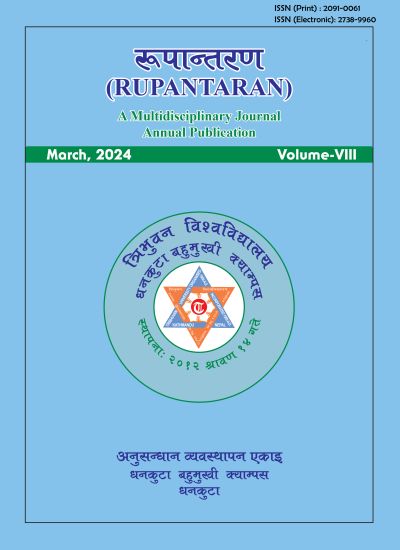शिक्षण सिकाइमा बहुबौद्धिकता सिद्धान्तको उपयोग (Utilization of the Principle of Multi-Intelligence in Teaching-Learning)
DOI:
https://doi.org/10.3126/rupantaran.v8i01.65209Keywords:
दक्षता ( Competence), प्रतिभा ( talent), बहुबौद्धिकता ( multi-intelligence ), शिक्षण ( teaching ), सिकाइ (learning)Abstract
प्रस्तुत लेखमा शिक्षकले शिक्षण सिकाइ गर्दा बहुबौद्धिकता सिद्धान्तको आधारमा शिक्षण गर्नुपर्ने आवश्यकताका सम्बन्धमा छलफल गरिएको छ । बहुबौद्धिकता सिद्धान्तको उपयोगसम्बन्धमा भए गरेका पूर्वकार्यहरूलाई हेर्दा बालबालिकाहरूका विभिन्न प्रकारका प्रतिभा प्रस्फुटनका लागि हाम्रा विद्यालयहरूमा शिक्षकले शिक्षण सिकाइ कार्यकलाप सञ्चालन गर्दा हवार्ड गार्डनर (सन् १९४३) को बहुबौद्धिकता सिद्धान्तको ख्याल कमै गर्ने गरेको पाइन्छ । यही तथ्य नै यस लेखको प्राज्ञिक समस्या हो । यो समस्याको समाधानका लागि गार्डनरद्वारा प्रतिपादित बहुबौद्धिकताको सैद्धान्तिक परिचयका सापेक्षतामा शिक्षकले शिक्षण सिकाइ गर्दा बहुबौद्धिकता सिद्धान्तलाई उपयोग गरेर शिक्षण कार्य गर्न प्रेरित गर्नु यस लेखको उद्देश्य हो । गार्डनको 'मल्टिपल इन्टिलिजेन्सेज' भन्ने सिद्धान्तलाई यस लेखको सैद्धान्तिक आधार बनाइएको छ । गुणात्मक अनुसन्धान ढाँचामा आधारित यस लेखमा मूलतः पुस्तकालय कार्य र इन्टरनेटका वेभसाइटबाट सङ्कलित सामग्रीहरूलाई वर्णनात्मक अध्ययन विधिको प्रयोग गरेर निष्कर्ष प्रस्तुत गरिएको छ । यस सन्दर्भमा गार्डनरको बहुबौद्धिकता सिद्धान्तका नौवटा बौद्धिकताहरू शाब्दिक/भाषिक बौद्धिकता, तार्किक/गणितीय बौद्धिकता, स्थानगत/दृश्यात्मक बौद्धिकता, शारीरिक–गतिक बौद्धिकता, साङ्गीतिक बौद्धिकता, अन्तः वैयक्तिक बौद्धिकता, अन्तर वैयक्तिक बौद्धिकता, प्रकृतिवादी बौद्धिकता र आध्यात्मिक/अस्तित्ववादी बौद्धिकताका सम्बन्धमा प्रकाश पार्दै कक्षाकोठामा शिक्षकले सञ्चालन गर्न सक्ने विविध सिकाइ क्रियाकलापलाई उद्घाटित गर्ने काम गरिएको छ । बालकमा अनेक प्रतिभाहरू विद्यमान हुन सक्छन् । शिक्षकले कक्षामा उनीहरूको रुचि र चाहनाअनुसारका कक्षा कार्यकलाप सञ्चालन गर्न सकेमा खास बालकका खास बौद्धिकताको उजागर हुन गई खास क्षेत्रमा उनीहरू दक्षता हासिल गर्न सक्षम हुन्छन् भन्ने प्रस्तुत लेखको निष्कर्ष रहेको छ ।
(This article discusses the necessity of teaching on the basis of the principle of multi-intelligence by the teachers. Reflecting on the prior act on multi-intelligence utility, teachers of our schools seem not to be mindful about Howard Gardener’s (1943 AD) principle of multi-intelligence regarding the skill enhancing various activities. This fact is the academic issue of this article. The main objective of this article is to solve this problem by inspiring the teachers to teach the students applying the principle of multi-intelligence through the introduction of Gardener propounded multi-intelligence principle’s relativity. The principle foundation of this article is Gardener’s principle of ‘Multiple Intelligence’. Based on qualitative research pattern, the conclusion of this article has mainly been derived by adapting descriptive study method of the materials collected from library and internet websites. In this regard, shedding the lights on Garderner’s multi-intelligence principle’s nine intelligence: visual-spatial, verbal-linguistic, music-rhythmic, logical/mathematical, interpersonal, intrapersonal, naturalistic and bodily-kinesthetic intelligence, various learning activities are launched for the teachers to accommodate in the classroom. Many abilities are prevalent in the children. This article concludes that special children’s special intelligence will be exposed by enabling them to accomplish efficiency if the teachers conduct classroom activities as per the interest and desire of the students in the classroom.)
Downloads
Downloads
Published
How to Cite
Issue
Section
License
© Research management Cell (RMC); Dhankuta Multiple Campus, Dhankuta; Province-1, Nepal

